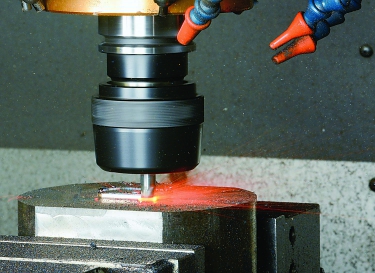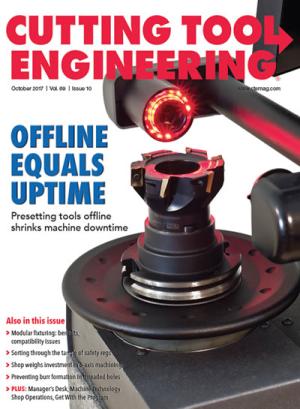Imagine machining Inconel 718 and similar heat-resistant superalloys (HRSAs) at cutting speeds normally reserved for aluminum. Melissa Singher, senior product coordinator for NTK Cutting Tools U.S.A., Wixom, Mich., said this improbable task is not only possible but becoming an accepted practice at some aerospace OEMs.
The secret is the toolmaker’s SX9 ceramic endmills, according to Singher.
“When machining superalloys, such as Inco 718 and 625, using SX9 endmills, you will typically use speeds of 2,000 to 3,000 sfm, with a minimum speed of about 1,000 sfm,” Singher said. “As an example, a ½" endmill requires a minimum of 8,000 rpm and, for optimum performance, should be run in the range of 15,000 to 20,000 rpm. Feed rates will typically range from 0.0011 to 0.0013 ipt, or more than 100 ipm for a 4-flute endmill at 20,000 rpm.”

Dust follows the SX9 endmill from NTK Cutting Tools as it cuts a workpiece made from a heat-resistant superalloy. Image courtesy of NTK Cutting Tools U.S.A.
At first glance, machining with one of these tools might have you running for the fire extinguisher. But what appears to be a glowing mass of chips that will soon ignite and a cutter that will soon be ready for the recycling bin is really an efficient metal-removal process, one that—applied correctly—offers tool life of 10 to 25 minutes, Singher said. She explained that SX9 is a SiAlON, or silicon-alumina nitride, ceramic that blends the strength of silicon nitride with the heat and wear resistance of alumina oxide. The cutting edge was reportedly developed to withstand the extreme heat and pressure generated when machining HRSAs at high cutting speeds.
Workhardening is common under such high cutting-speed conditions, which is why the endmills are mainly used for roughing. A finishing pass with a carbide endmill at least 0.3mm (0.012") in diameter is typically needed, Singher added.
Some additional rules of thumb for SiAlON endmills:
- Climb cutting is always recommended.
- Because of the high temperatures involved, continuous toolpaths reduce thermal shock to the tool.
- To cut internal pockets, ramp in at a 1.5° angle and feed 50 percent slower than normal.
- Ceramic endmills are not suitable for machining titanium because the heat generated reacts unfavorably with this material.
- Apply 6-flute endmills instead of 4-flute tools whenever possible to maximize productivity.
In addition, select high-speed, balanced hydraulic or shrink-fit chucks or arbors. Cutting fluid must not be used; instead, blast air directly at the chuck body to prevent expansion because of the tremendous heat generated during
machining.
Lastly, don’t be surprised at the price tag. Ceramic endmills sell for a much higher price than high-quality carbide ones, but the greater throughput easily justifies the added cost.
Singher said, “Due to the highly competitive atmosphere in the engine component industry, we see great interest in this product from Tier 1 and Tier 2 subcontractors. These companies truly see the potential of productivity 15 to 40 times that offered by carbide endmills, resulting in major reductions in manufacturing time on complex HRSA components.”
Contact Details
Related Glossary Terms
- chuck
chuck
Workholding device that affixes to a mill, lathe or drill-press spindle. It holds a tool or workpiece by one end, allowing it to be rotated. May also be fitted to the machine table to hold a workpiece. Two or more adjustable jaws actually hold the tool or part. May be actuated manually, pneumatically, hydraulically or electrically. See collet.
- cutting fluid
cutting fluid
Liquid used to improve workpiece machinability, enhance tool life, flush out chips and machining debris, and cool the workpiece and tool. Three basic types are: straight oils; soluble oils, which emulsify in water; and synthetic fluids, which are water-based chemical solutions having no oil. See coolant; semisynthetic cutting fluid; soluble-oil cutting fluid; synthetic cutting fluid.
- endmill
endmill
Milling cutter held by its shank that cuts on its periphery and, if so configured, on its free end. Takes a variety of shapes (single- and double-end, roughing, ballnose and cup-end) and sizes (stub, medium, long and extra-long). Also comes with differing numbers of flutes.
- feed
feed
Rate of change of position of the tool as a whole, relative to the workpiece while cutting.
- inches per minute ( ipm)
inches per minute ( ipm)
Value that refers to how far the workpiece or cutter advances linearly in 1 minute, defined as: ipm = ipt 5 number of effective teeth 5 rpm. Also known as the table feed or machine feed.
- inches per tooth ( ipt)
inches per tooth ( ipt)
Linear distance traveled by the cutter during the engagement of one tooth. Although the milling cutter is a multi-edge tool, it is the capacity of each individual cutting edge that sets the limit of the tool, defined as: ipt = ipm/number of effective teeth 5 rpm or ipt = ipr/number of effective teeth. Sometimes referred to as the chip load.
- superalloys
superalloys
Tough, difficult-to-machine alloys; includes Hastelloy, Inconel and Monel. Many are nickel-base metals.
- wear resistance
wear resistance
Ability of the tool to withstand stresses that cause it to wear during cutting; an attribute linked to alloy composition, base material, thermal conditions, type of tooling and operation and other variables.
- workhardening
workhardening
Tendency of all metals to become harder when they are machined or subjected to other stresses and strains. This trait is particularly pronounced in soft, low-carbon steel or alloys containing nickel and manganese—nonmagnetic stainless steel, high-manganese steel and the superalloys Inconel and Monel.



